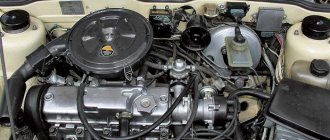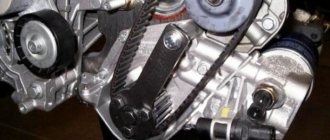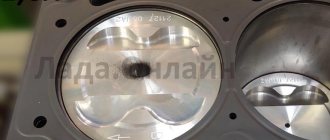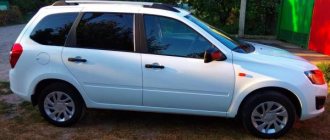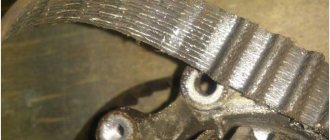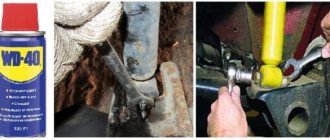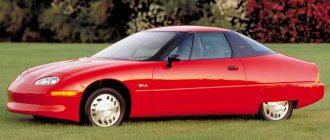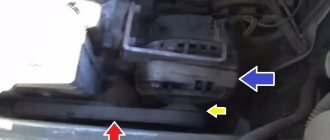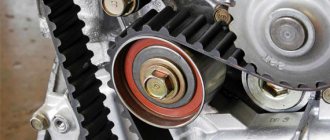The constant improvement of the internal combustion engine in order to increase efficiency and improve fuel efficiency has forced engineers to seriously rework the timing structure of modern diesel and gasoline engines. Changes also affected the design of the piston group and combustion chamber. These modifications were made to maximize the efficient filling of the cylinders and their high-quality ventilation, that is, to obtain improved gas exchange.
We also recommend reading the article about what a variable valve timing system is. From this article you will learn about what types of these solutions are installed on different engines, as well as the operating principles and design features of such systems.
If in the early stages of development the most common engine was with two valves per cylinder (1 intake and 1 exhaust valve), today an increase in the number of valves per cylinder is everywhere observed. Such changes are well illustrated by the most common version of the automobile internal combustion engine with four cylinders. Previously, such engines were often 8-valve, with one camshaft. Today, such a unit is often a 16-valve version with two camshafts (for intake and exhaust valves), can be equipped with a variable valve timing system, etc.
Why does the valve bend when the timing belt breaks?
You're driving along in your wonderful car, and suddenly there's a knock and the car stops. This is how the belt breaks. Everything would be fine if the belt just broke, but on some engines the valves immediately bend. Why is this happening?
The fact is that when the timing belt breaks, the camshaft, which drives the valve, stops, and the internal combustion engine crankshaft continues to rotate and push the pistons. The valves that are supposed to close remain in the lowered position and the rising pistons meet them.
How valves bend:
- The timing chain or belt has broken.
- The camshaft has stopped rotating.
- The crankshaft continues to rotate and push the pistons.
- Valves that go down and pistons that go up meet at top dead center (TDC).
- Pistons are stronger than valves, so the pistons bend the valves.
That is, if the timing belt breaks, the camshaft stops abruptly, and the engine crankshaft (even if it was immediately turned off) continues to rotate. The camshaft stops instantly and has no residual rotation because the return springs brake its cams. While the internal combustion engine crankshaft is rotating, the pistons will hit the open valves. Although the material of the pistons is stronger and more durable, it happens that the pistons themselves break when they meet the valves.
How to understand that the valve is bent
If the belt breaks, there is a small chance of no damage to the engine. Before removing the cylinder head, it is necessary to measure the compression in the cylinders if the crankshaft can be turned. If the valves are damaged, there will be a lack of compression. It is always necessary to disconnect the battery when carrying out repair work on the engine. To facilitate rotation of the crankshaft, it is necessary to remove the spark plugs for a gasoline engine or the glow plugs for a diesel engine.
The crankshaft can only be rotated in its normal position (usually clockwise).
On which engines do valves bend?
We present a list of cars of different brands and models in the table. Engines on the same machines can be different, so each brand will have its own table, in which there is a column indicating “bend” and a column indicating “do not bend”. So, let's go, let's start with the most popular cars in Russia:
VAZ timing belt broke
| Motor | Oppression? | Motor | Oppression? | |
| 2111 1.5 16cl. | Yes | 2111 1.5 8kl. | No | |
| 2103 | Yes | 21083 1.5 | No | |
| 2106 | Yes | 21093, 2111, 1.5 | No | |
| 21091 1.1 | Yes | 21124, 1.6 | No | |
| 20124 1.5 16v | Yes | 2113, 2005 1.5 engineering, 8 classes | No | |
| 2112, 16 valves, 1.5 | bending (with stock pistons) | 11183 1.6 l 8 cl. "Standard" (Lada Granta) | No | |
| 21126, 1.6 | Yes | 2114 1.5, 1.6 8 cells. | No | |
| 21128, 1.8 | Yes | 21124 1.6 16 cl. | No | |
| Lada Vesta 1.6 with engine 21129 (106 hp) | Yes | |||
| Lada Vesta 1.8 with engine 21179 (122 hp) | Yes | |||
| Lada Kalina Sport 1.6 72kW | Yes | |||
| 21116 16 class. “Norma” (Lada Granta) | Yes | |||
| 2114 1.3 8 cells and 1.5 16 cl | oppression | |||
| Lada Largus K7M 710 1.6l. 8kl. and K4M 697 1.6 16 cl. | Yes | |||
| Niva 1.7l. | Yes |
The photo shows a VAZ 2110 valve
Lada Granta valves bent
Lada Largus valves bent
On the Lada Priora, not only the valves were bent, but the piston was also broken
Timing belt RENAULT / RENO broke
| Motor | Oppression? |
| Logan, Clio, Clio 2, Laguna 1, Megane Classic, Kangu, Symbol | oppression (in most cases) |
| K7J 1.4 8cl | Yes |
| K4J 1.4 16 cl. | Yes |
| F8Q 622 1.9D | Yes |
| 1.6 16V K4M | Yes |
| 2.0 F3R | Yes |
| 1.4 RXE and all engines are reno, both 8 and 16 cl. | Yes |
| Master g9u720 2.8 (design) | Yes |
Timing belt KIA / KIA broke
| Motor | Oppression? | Motor | Doesn't bend | |
| Spectra 1.6 | Yes | D4EA | doesn't bend | |
| Rio A3E 1343cm3 8cl. A5D 1.4 l., 1.5 l. 1.6kl. | Yes | |||
| Magentis(Majestic) G4JP 2l. | Yes | |||
| Serato, Spektra 1.6 16v | Yes | |||
| Seed 1.4 16kl. | Yes |
Timing belt PEUGEOT / PEUGEOT broke
| Motor | Oppression? | Motor | Doesn't bend |
| 307 TU5JP4 1.6 | Yes | 607 2.2 hdi 133 hp | does not bend (but breaks the rocker, the car stalls without any noise) |
| 206 TU3 1.4 | Yes | Boxer 4HV, 4HY | does not bend (but breaks the rocker) |
| 405 1.9l. benz | Yes | ||
| 407 PSA6FZ 1.8l. | Yes |
FORD timing belt broke
| Motor | Oppression? | Motor | Doesn't bend |
| zetek 1.8 l | Yes | zetek 2.0 l | doesn't bend |
| Focus II 1.6l. 16v | Yes | Sierra 2.0 CL OHC 8 cl. | doesn't bend |
| Mondeo 1.8 GLX 16 cl. | oppression + hydraulic compensators jam |
HONDA timing belt broke
| Motor | Oppression? | Motor | Doesn't bend | |
| Accord | Yes | Civic B15Z6 | doesn't bend | |
| D15B | Yes | SOHC | doesn't bend |
Engines of MITSUBISHI / MITSUBISHI cars
| Motor | Oppression? | Motor | Doesn't bend | |
| 6g73 2.5 GDI | bending (does not bend at low speeds) | Pajero 2, 3.0 l, 12 cl. | doesn't bend | |
| 4G18, 16 valves, 1600cm2 | Yes | |||
| Airtrek 4G63 2.0L turbo | Yes | |||
| Carisma 1.6 | Yes | |||
| Montero Sport 6g72, 3.0, v6, 177 hp | Yes |
NISSAN car engines / NISSAN
| Motor | Oppression? | Motor | Doesn't bend | |
| Nissan Cefiro A32 VQ20DE | Yes | RB\VG\VE\CA | doesn't bend | |
| Nissan with HR16DE engine | does not bend because the drive is a chain | |||
| Nissan Primera 2.0D 8 cl. | Yes | |||
| Nissan Skyline RB25DET NEO | bends, and the RB20E breaks the rocker | |||
| Nissan Sunny QG18DD NEO | Yes |
OPEL car engines
| Motor | Oppression? | Motor | Oppression? | |
| X14NV | Yes | 13S | No | |
| X14NZ | Yes | 13N/NB | No | |
| C14NZ | Yes | 16SH | No | |
| X14XE | Yes | C16NZ | No | |
| X14SZ | Yes | 16SV | No | |
| C14SE | Yes | X16SZ | No | |
| X16NE | Yes | X16SZR | No | |
| X16XE | Yes | 18E | No | |
| X16XEL | Yes | C18NZ | No | |
| C16SE | Yes | 18SEH | No | |
| Z16XER | Yes | 20SEH | No | |
| C18XE | Yes | C20NE | No | |
| C18XEL | Yes | X20SE | No | |
| C18XER | Yes | Cadet 1.3 1.6 1.8 2.0 l. 8kl. | No | |
| C20XE | Yes | 1.6 if 8th grade. | No | |
| C20LET | Yes | |||
| X20XEV | Yes | |||
| Z20LEL | Yes | |||
| Z20LER | Yes | |||
| Z20LEH | Yes | |||
| X22XE | Yes | |||
| C25XE | Yes | |||
| X25X | Yes | |||
| Y26SE | Yes | |||
| X30XE | Yes | |||
| Y32SE | Yes | |||
| Corsa 1.2 8v | Yes | |||
| Cadet 1.4 l | Yes | |||
| all 1.4, 1.6 16V | Yes |
Engines of MAZDA cars / MAZDA
| Motor | What will happen? | Motor | What will happen? | |
| E 2200 2.5 l. diz. | will bend | 323f 1.5 l. Z5 | won't bend | |
| 626 GD FE3N 16V | will bend | Xedos 6, 2.0l., V6 | won't bend | |
| MZD Capella (Mazda Capella) FE-ZE | won't bend | |||
| F2 | won't bend | |||
| FS | won't bend | |||
| FP | won't bend | |||
| KL | won't bend | |||
| KJ | won't bend | |||
| ZL | won't bend |
Engines of SUBARU / SUBARU cars
| Motor | Oppression? | Motor | Oppression? | |
| EJ25D DOHC and EJ251 | Yes | EJ253 2.5 SOCH | will not bend (only if at idle speed) | |
| EJ204 | Yes | EJ20GN | No | |
| EJ20G | Yes | EJ20(201)DOHC | No | |
| EJ20(202)SOHC | Yes | |||
| EJ 18 SOHC | Yes | |||
| EJ 15 | Yes |
VAG engines that are installed on AUDI, VOLKSWAGEN and SKODA cars
| Motor | Oppression? | Motor | Oppression? | |
| ADP 1.6 | Yes | 1.8RP | No | |
| AUDI A6 C4 2.5 TDI (tdi) | Yes | |||
| Polo 2005 1.4 | Yes | 1.8 AAM | No | |
| Conveyor T4 ABL 1.9 l | Yes | 1.8PF | No | |
| GOLF 4 1.4/16V AHW | Yes | 1.6 EZ | No | |
| PASSAT 1.8 l. 20V | Yes | 2.0 2E | No | |
| Passat B6 BVY 2.0FSI | bends + breaks valve guides | 1.8PL | No | |
| 1.4 VSA | Yes | 1.8 AGU | No | |
| 1.4 BUD | Yes | 1.8 EV | No | |
| 2.8 AAA | Yes | 1.8 ABS | No | |
| 2.0 9A | Yes | 2.0JS | No | |
| 1.9 1Z | Yes | |||
| 1.8 KR | Yes | |||
| 1.4 BBZ | Yes | |||
| 1.4 ABD | Yes | |||
| 1.4 VSA | Yes | |||
| 1.3 MN | Yes | |||
| 1.3 HK | Yes | |||
| 1.4 AKQ | Yes | |||
| 1.6 ABU | Yes | |||
| 1.3 NZ | Yes | |||
| 1.6 BFQ | Yes | |||
| 1.6CS | Yes | |||
| 1.6 AEE | Yes | |||
| 1.6 AKL | Yes | |||
| 1.6 AFT | Yes | |||
| 1.8AWT | Yes | |||
| 2.0 BPY | Yes |
BMW car engines (BMW)
| Motor | Will it bend? |
| BMW N46 (BMW N46 - 4-cylinder petrol engine) | No |
Car engines MERSEDES-BENZ (MERCEDES-BENZ)
| Motor | Will it bend? |
| 271 motor | Yes |
| W123 615.616 (petrol, diesel) | Yes |
VOLVO car engines / VOLVO
| Motor | What will happen to the valves? |
| S40 1.6 (belt) | will bend |
| 740 2.4D | will bend (and possibly break the camshaft and lifters) |
FIAT / FIAT car engines
| Motor | What will happen to the valves? |
| Brava 1600 cm3 16 cl. | Yes |
| Tipo and Tempra 1.4, 8-valve. and 1.6 l | bend (some of these models do not bend) |
| Tipo and Tempra 1.7 diesel | Yes |
| Ducato 8140 | will bend (and break the rockers) |
| Ducato F1A | Yes |
| Fiat Ducato 2.8 turbodiesel | Yes |
| Fiat Croma 2.0 8 valve | Yes |
| Fiat Croma 2.0 16 valve | Yes |
Engines of HYUNDAI cars (HYUNDAI, HUNDAI)
| Motor | Will they bend or not? |
| Getz 1.3 12cl | Yes |
| Getz 1.4 16cl | Yes |
| Accent SOHC 1.5 12V and DOHC 1.5 16v | Yes |
| H 200, D4BF | Yes |
| Elantra, G4FC | Yes |
| Sonata, 2.4l | Yes |
CITROEN car engines
| Motor | Will it bend? |
| Citroen Xantia XU10J4R 2.0 16cl | Yes |
| Citroen ZX 1.9 and 2.0 (diesel) | Yes |
| Citroen C5 2.0 136 hp | Yes |
| Citroen C4 1.6i 16V | Yes |
| Citroen jumper 2.8 HDI | Yes |
| Citroen Berlingo 1.4 and 1.6 | Yes |
| Citroen Xsara 1.4 TU3JP | Yes |
Engines of CHEVROLET / CHEVROLET cars
| Engine | Oppression |
| Aveo 1.4 F14S3, 8 cells. | Yes |
| Aveo 1.4 F14D3 16cl. | Yes |
| Aveo 1.6 | Yes |
| Aveo 1.4 F14S3 | Yes |
| Lacetti 1.6l. and 1.4l. | Yes |
| Captiva LT 2.4 l. | Yes |
Turbocharged engines are more economical and produce more power. In such internal combustion engines, fuel burns better. The operating principle of turbochargers was discussed in detail.
Car engines DAEWOO / Daewoo
| Motor | Oppression | Motor | Doesn't bend |
| Lanos 1.5 | Yes | Lanos, Sens 1.3 | doesn't bend |
| Lanos 1.6 | Yes | Nexia 1.6. 16 Uzbek. | doesn't bend |
| Matiz 0.8 | bend and also replace the guide | Nexia 1.5. 8 (Euro-2 G15MF cars until 2008) | doesn't bend |
| Nexia A15SMS (Euro-3, after 2008) | Yes | ||
| Nubira 1.6l. DOHC | Yes | ||
| Nexia 1.6 liters, 16 valve, F16D3 , according to Alexander’s review, in the comment at the end of the article, 4 valves were bent and the hydraulic compensators became unusable. | bends and breaks hydraulic compensators |
The photo shows bent valves of the Daewoo Nexia
Daewoo Lanos valves
No, not a mistake. The Lanos model is available not only at Chevrolet, but also at Daewoo.
Car engines SUZUKI / SUZUKI, SUZUKI
| Motor | What happens if the belt breaks? |
| G16A (1.6L 8 valve) | won't bend |
| G16B (1.6 l 16 cl.) | won't bend |
Car engines TOYOTA / TOYOTA
| Motor | Oppression | Motor | Doesn't bend |
| 1C | Yes | Camry V10 2.2GL | doesn't bend |
| 2C | Yes | 3VZ | doesn't bend |
| 2E | Yes | 1S | doesn't bend |
| 3S-GE | Yes | 2S | doesn't bend |
| 3S-GTE | Yes | 3S-FE | doesn't bend |
| 3S-FSE | Yes | 4S-FE | doesn't bend |
| 4A-GE | oppression (does not oppress at idle) | 5S-FE | doesn't bend |
| 1G-FE VVT-i | Yes | 4A-FHE | doesn't bend |
| G-FE Beams | Yes | 1G-EU | doesn't bend |
| 1JZ-FSE | Yes | 3A | doesn't bend |
| 2JZ-FSE | Yes | 1JZ-GE | doesn't bend |
| 1MZ-FE VVT-i | Yes | 2JZ-GE | doesn't bend |
| 2MZ-FE VVT-i | Yes | 5A-FE | doesn't bend |
| 3MZ-FE VVT-i | Yes | 4A-FE | doesn't bend |
| 1VZ-FE | Yes | 4A-FE LB | does not bend (running on lean mixture (lean burn)) |
| 2VZ-FE | Yes | 7A-FE | |
| 3VZ-FE | Yes | 7A-FE LB | does not bend (running on lean mixture (lean burn)) |
| 4VZ-FE | Yes | 4E-FE | doesn't bend |
| 5VZ-FE | Yes | 4E-FTE | doesn't bend |
| 1SZ-FE | Yes | 5E-FE | doesn't bend |
| 2SZ-FE | Yes | 5E-FHE | doesn't bend |
| 1G-FE | doesn't bend | ||
| 1G-GZE | doesn't bend | ||
| 1JZ-GE | does not bend (in practice it is possible) | ||
| 1JZ-GTE | doesn't bend | ||
| 2JZ-GE | does not bend (in practice it is possible) | ||
| 2JZ-GTE | doesn't bend | ||
| 1MZ-FE type'95 | doesn't bend | ||
| 3VZ-E | doesn't bend |
GEELY / GILI car engines
| Motor | Oppression | Motor | Doesn't bend | |
| Geely Emgrand EC7 1.5 JL4G15 and 1.8 JL4G18 CVVT | Yes | Geely CK/MK 1.5 5A-FE | doesn't bend | |
| Geely MK 1.6 4A-FE | doesn't bend | |||
| Geely FC 1.8 7A-FE | doesn't bend | |||
| Geely LC 1.3 8A-FE | doesn't bend |
Car engines LIFAN / LIFAN
| Motor | What will happen? |
| LF479Q3 1.3l. | won't bend |
| Tritec 1.6l. | won't bend |
| 4A-FE 1.6l. | won't bend |
| 5A-FE 1.5l. and 1.8l. 7A-FE | won't bend |
Car engines CHERY / CHERRY
| Motor | What will happen? |
| Tiggo 1.8l., 2.4l. 4G64 | will bend |
| Amulet SQR480ED | the rocker arms will bend and break |
| A13 1.5 | will bend |
| Chery Bonus 3 (Chery Bonus 3), 16 cl, 1.5 l | will bend |
Car engines Faw / Fav
| Motor | What will happen? |
| Besturn B50, 1.6 liters, 103 hp. | will bend |
VAZ engines – “non-stick” and “risky”
Since several power plants are installed on each of the VAZ models, it is important to know which of them are “plug-in”.
As already noted, the classic VAZ (2101-2107) and VAZ Niva were equipped with power units in which the valves bend. But since the timing drive on these engines is a chain drive, “stick-in” can not be taken into account.
"Samara"
The following were installed on cars of the Samara family (VAZ 2108-21099):
- Units marked VAZ 21081, 2108 (carburetor and injection);
- Motors 21083, 21091;
- 8-valve VAZ-2111 (models of later years of production).
Of these, units 21083 and 2111 did not bend the valves when the timing belt broke, but versions 21081 and 2108 were “risky”.
VAZ 2110-2112
On models of the 10th family (VAZ-2110-2112), the range of power plants is even more extensive. Some units were installed on all cars of this family, while some were offered only for certain models.
Common to all models were engines with the indexes VAZ-2110, 2111 (8-valve), 2112, 21114, 21124. Of these, the VAZ-2112 and 21114 engines are “plug-in”, and the remaining valves do not bend.
Additionally, the VAZ-2112 model car was equipped with a VAZ-21128 power unit, which is also “risky” and bends the valves when the timing belt breaks.
"Samara-2"
Cars of the Samara-2 family, which includes the VAZ 2113-2115 models, are equipped with units of the VAZ-2111, 21114, 21124 and 21126 brands. Of these, only VAZ-2111 and 21124 engines are “risk-free”.
Also for the VAZ-2113 and 2115 versions, a motor with index 11183 was offered, in which a broken belt does not lead to bending of the valves.
"Granta", "Kalina", "Priora"
The Lada Granta is equipped with a line of units of the following brands: 11183, 11186, 21126 and 21128. The last two of them are also equipped with the Granta Sport version. Of all the engines, only version 11183 is “non-plug-in”, the rest have bent valves.
For the Lada Kalina, engines of the VAZ brands 11183, 11186, 11194, 21126 and 21127 are offered. The last two units are also installed on the Kalina Sport model, and the Cross version is equipped with engines 21127 and 11186. Of the entire line, only the VAZ-11183 engine does not bend valves when the timing belt breaks.
Lada Priora is equipped with units with indexes 21114, 21116, 21126 and 21127. All these engines are plug-in.
Please note that only the main brands of power plants that are equipped with certain models are listed above. But AvtoVAZ almost always “sins” with experimental small-scale production, when units that are uncharacteristic for it are installed on some cars.
For example, the VAZ-2109 was equipped with an engine with an identical index, which differed from the 2108 version in a lightweight design, and the small VAZ-2108 series was even equipped with a rotary unit labeled VAZ-415.
READ ON THE TOPIC: Other characteristic malfunctions of the VAZ 2110 and other models of the series.
Why does the timing belt break?
As the experience of breakdowns shows, belts do not break only because they are worn out or are of poor quality. There are several more reasons:
- belt wear (especially if there is even a slight misalignment and the belt touches the side of the pulley);
- if the crankshaft of the internal combustion engine is jammed;
- if the pump (the pump that circulates the coolant) has stalled;
- if the belt tension roller is jammed.
The new generation of motors often break down. This is due to the fact that they are being made more and more powerful. The distance between the valves and pistons located at top dead centers is becoming smaller and smaller. Therefore, even if the valves are slightly open and they did not have time to close before the pistons arrived, they are instantly bent.
Ways to solve the problem
Since the collision of pistons with valves has quite serious negative consequences, many car enthusiasts are interested in whether it is possible to influence this situation.
There are several methods that allow you to convert a valve-bending motor into a “plug-inless” one.
The simplest of them is installing pistons with grooves. By the way, on some VAZ engines this is how the problem with “sticking” is solved.
On the bottom of such pistons there are special recesses for valve plates. Due to this, the latter in the open position do not come into contact with the pistons installed at TDC.
But not all engines can be modernized in this way, for the reason that it is not always possible to find pistons with factory-made grooves to replace the “original” ones.
The second method is to independently make grooves on the piston. This method is suitable for those who have not found replacement “non-stick” pistons. But this method has a significant drawback - it is very difficult to make identical recesses on all pistons. As a result, an imbalance in the weight of the pistons may occur, which will affect the service life of the crankshaft. Also, grooves of different sizes can cause different compression in the cylinders, and this problem cannot be eliminated.
The third method is to increase the height of the combustion chamber. This is done by installing 2-3 gaskets under the head of the block. This method has a negative side - an increase in the volume of the combustion chamber, which entails a drop in compression, and as a result - a decrease in power and an increase in fuel consumption.
How do you know if the valves on a specific make and model of car are bent?
This is actually a good question, and all drivers need to know the answer. Be prepared, in the event that the timing belt or timing chain breaks, for repairs such as replacing valves, adjusting them, and so on, or, knowing that it does not bend, do not worry again, but carry a spare timing belt with you (if Belting).
If the owner's manual for a particular make and model says it won't bend and you don't trust it, or it doesn't say this information at all, there is a practical method for calculating whether the valves on that machine will bend.
In order to find out, you will need:
- remove the casing;
- remove the timing belt;
- set the first piston to TDC;
- slowly rotate the camshaft 720 degrees (that’s two full turns). If the valve does not rest against the piston, it means it does not reach it.
- set the second piston to TDC;
- Also, turn the camshaft 2 full turns. If the piston does not touch the valve, then everything is fine.
Cost to repair bent valves
Repairs of this type usually cost the car owner quite a lot, at least 15 thousand rubles, and in the event of a head injury, the amount can increase significantly. In case of severe damage, even a new head may be required, and rebuilding does not make sense.
Bent valves must not be bent back! Some unscrupulous car services say that they have spare parts for your car in stock, but in fact they bend them back, which is unacceptable. Be sure to ask to show the deformed parts after the repair.
In order to avoid bending the valves on a car, it is necessary to promptly replace the timing belt on cars, and also remember that the cost of replacing a timing belt is 10% of the cost of repair work if it breaks.
Useful tips on the topic
Following the recommendations will make life easier for the driver and the engine of his car:
- find out whether the valves in your car’s engine are bent using a table, a reference book, or with your own hands;
- Carry a spare timing belt with you;
- buy a good quality belt (it’s better to always use the same brand);
- periodically check the belt tension and conduct a visual inspection for cuts, burrs, and detachments of ropes;
- when buying a used car from a stranger, it is recommended to change the timing belt, even if the former owner said that he recently replaced it;
0
Author of the publication
offline 1 month
